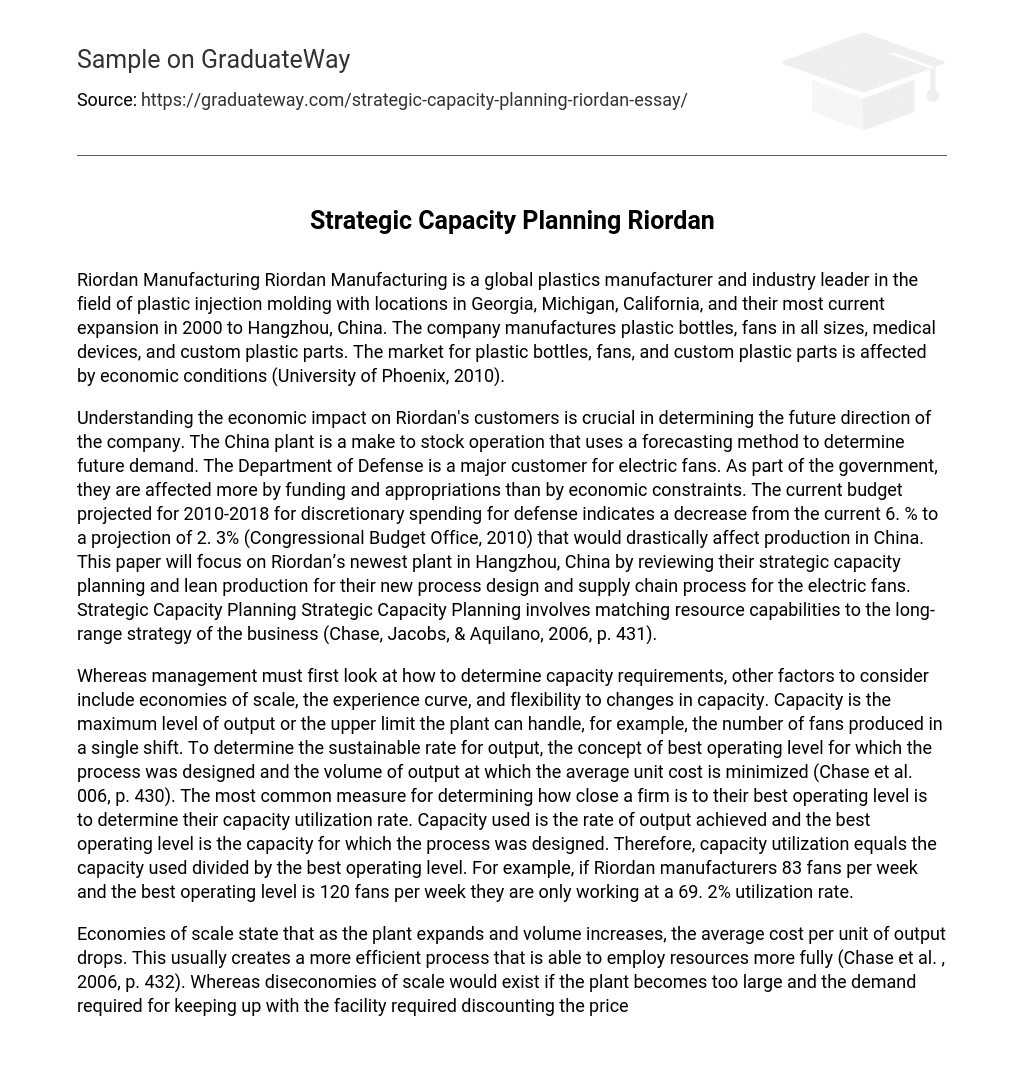Riordan Manufacturing Riordan Manufacturing is a global plastics manufacturer and industry leader in the field of plastic injection molding with locations in Georgia, Michigan, California, and their most current expansion in 2000 to Hangzhou, China. The company manufactures plastic bottles, fans in all sizes, medical devices, and custom plastic parts. The market for plastic bottles, fans, and custom plastic parts is affected by economic conditions (University of Phoenix, 2010).
Understanding the economic impact on Riordan’s customers is crucial in determining the future direction of the company. The China plant is a make to stock operation that uses a forecasting method to determine future demand. The Department of Defense is a major customer for electric fans. As part of the government, they are affected more by funding and appropriations than by economic constraints. The current budget projected for 2010-2018 for discretionary spending for defense indicates a decrease from the current 6. % to a projection of 2. 3% (Congressional Budget Office, 2010) that would drastically affect production in China. This paper will focus on Riordan’s newest plant in Hangzhou, China by reviewing their strategic capacity planning and lean production for their new process design and supply chain process for the electric fans. Strategic Capacity Planning Strategic Capacity Planning involves matching resource capabilities to the long-range strategy of the business (Chase, Jacobs, & Aquilano, 2006, p. 431).
Whereas management must first look at how to determine capacity requirements, other factors to consider include economies of scale, the experience curve, and flexibility to changes in capacity. Capacity is the maximum level of output or the upper limit the plant can handle, for example, the number of fans produced in a single shift. To determine the sustainable rate for output, the concept of best operating level for which the process was designed and the volume of output at which the average unit cost is minimized (Chase et al. 006, p. 430). The most common measure for determining how close a firm is to their best operating level is to determine their capacity utilization rate. Capacity used is the rate of output achieved and the best operating level is the capacity for which the process was designed. Therefore, capacity utilization equals the capacity used divided by the best operating level. For example, if Riordan manufacturers 83 fans per week and the best operating level is 120 fans per week they are only working at a 69. 2% utilization rate.
Economies of scale state that as the plant expands and volume increases, the average cost per unit of output drops. This usually creates a more efficient process that is able to employ resources more fully (Chase et al. , 2006, p. 432). Whereas diseconomies of scale would exist if the plant becomes too large and the demand required for keeping up with the facility required discounting the price. When a plant gains economy of scale, it produces more. As plants produce more, they gain experience in the best production methods and reduce the costs of production.
Every time a plants cumulative production doubles, the production costs decline (Chase et al. , 2006, p. 432). Using capacity flexibility allows for the rapid increase or decrease in production levels or the ability to shift production capacity from one service to another. This requires flexible workers with multiple skills and the ability to switch tasks easily. Riordan employees all self-directed teams in which each team member is trained in multiple areas providing for this flexibility.
Adding capacity to achieve maximum output involves important considerations like maintaining system balance in which the required number of inputs and outputs are appropriate at each stage of manufacturing. Using a more synchronous method of adding capacity in which bottlenecks occur and the using buffer inventories in front of bottlenecks would help achieve maximum output. Upgrading a facility can be costly but failing to do so can also result in higher costs and less productivity. Upgrading adds additional direct costs because of new equipment and training and the opportunity cost of the plant not producing must be considered.
Conversely, infrequent expansion means excess capacity is carried as overhead until used (Chase et al. , 2006, p. 435). Currently all custom orders are done under individual contract at the Japan plant and are received randomly therefore; they are not able to be included in the forecast planning. The plant is currently keeping a safety stock of polymer on hand but no safety stock on motors. A major change to capacity utilization at the China plan would be to have all custom orders done at the Pontiac, Michigan plant where they already do all custom plastic parts.





